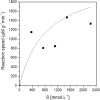Use of hydroxyapatite as a support in the immobilization of Thermomyces lanuginosus lipase for application in the production of biodiesel using a by-product as lipid raw material
- PMID: 38808300
- PMCID: PMC11128427
- DOI: 10.1007/s13205-024-04008-4
Use of hydroxyapatite as a support in the immobilization of Thermomyces lanuginosus lipase for application in the production of biodiesel using a by-product as lipid raw material
Abstract
The use of new materials in the field of biofuel production has been represented as a step in the development of remarkable catalysts. The use of lipases in the production of biodiesel is often seen as a cost-limiting step, as the operating expenses in recovering such catalysts can lead to unfeasible market expectations. In this study, hydroxyapatite (HAp) particles were evaluated as a support to immobilize commercial lipase, following application in ethyl ester synthesis. First, hydroxyapatite was synthesized through the co-precipitation method at constant pH and selected as a support to be used in enzyme immobilization. The characterization of the biocatalyst support materials produced was carried out using DRX, BET, FTIR, TGA, and SEM analysis. The lipase from Thermomyces lanuginosus was then immobilized in the matrices, and, subsequently, there was transesterification of the vegetable oil deodorization distillate (VODD). The biodiesel samples generated showed that they were within commercial standards, achieving ester conversion greater than 96.5%. Other properties such as density (0.87 g.cm-3) and viscosity (4.36 mm2.s-1) meet the specifications required by ASTM to be used as a biofuel. In the experiment planning technique, the results revealed an experimental trend and a defined behavior: a higher lipase loading in the immobilization and the use of temperatures in the range of 40-50 °C favor high conversions of ethyl esters. Thus, this confirms that the enzymatic chemical catalyst was able to form the main fatty acid esters even using a residual lipid raw material.
Keywords: Biodiesel; Hydroxyapatite; Lipase; Transesterification.
© King Abdulaziz City for Science and Technology 2024. Springer Nature or its licensor (e.g. a society or other partner) holds exclusive rights to this article under a publishing agreement with the author(s) or other rightsholder(s); author self-archiving of the accepted manuscript version of this article is solely governed by the terms of such publishing agreement and applicable law.
Conflict of interest statement
Conflict of interestThe authors declare that they have no conflict of interest.
Figures











Similar articles
-
Biodiesel Production from Citrillus colocynthis Oil Using Enzymatic Based Catalytic Reaction and Characterization Studies.Protein Pept Lett. 2018;25(2):164-170. doi: 10.2174/0929866524666170223150839. Protein Pept Lett. 2018. PMID: 28240158
-
Lipase-catalyzed biodiesel production and quality with Jatropha curcas oil: exploring its potential for Central America.J Biol Eng. 2015 Jul 24;9:12. doi: 10.1186/s13036-015-0009-9. eCollection 2015. J Biol Eng. 2015. PMID: 26213567 Free PMC article.
-
Biodiesel production from sunflower, soybean, and waste cooking oils by transesterification using lipase immobilized onto a novel microporous polymer.Bioresour Technol. 2009 Mar;100(6):1983-91. doi: 10.1016/j.biortech.2008.10.008. Epub 2008 Nov 22. Bioresour Technol. 2009. PMID: 19028094
-
An encapsulated report on enzyme-assisted transesterification with an allusion to lipase.3 Biotech. 2021 Nov;11(11):481. doi: 10.1007/s13205-021-03003-3. Epub 2021 Oct 30. 3 Biotech. 2021. PMID: 34790505 Free PMC article. Review.
-
Biodiesel production with immobilized lipase: A review.Biotechnol Adv. 2010 Sep-Oct;28(5):628-34. doi: 10.1016/j.biotechadv.2010.05.012. Epub 2010 May 24. Biotechnol Adv. 2010. PMID: 20580809 Review.
References
-
- Antczak MS, Kubiak A, Antczak T, Bielecki S. Enzymatic biodiesel synthesis–key factors affecting efficiency of the process. Renew Energy. 2009;34(5):1185–1194. doi: 10.1016/j.renene.2008.11.013. - DOI
-
- Ashkevarian S, Badraghi J, Mamashli F, Delavari B, Saboury AA. Covalent immobilization and characterization of Rhizopus oryzae lipase on core-shell cobalt ferrite nanoparticles for biodiesel production. Chin J Chem Eng. 2021;37:128–136. doi: 10.1016/j.cjche.2020.11.003. - DOI
-
- Barrett EP, Joyner LG, Halenda PP (1951) The determination of pore volume and area distributions in porous substances. I. Computations from nitrogen isotherms. J Am Chem Soc 73(1):373–380
-
- Bôas V, Renata N, Mendes MF. A review of biodiesel production from non-edible raw materials using the transesterification process with a focus on influence of feedstock composition and free fatty acids. J Chil Chem Soc. 2022;67(1):5433–5444. doi: 10.4067/S0717-97072022000105433. - DOI
-
- Brasil H, Pereira P, Corrêa J, Nascimento L, Rumjanek V, Almeida V, Rodrigues E. Preparation of hydrotalcite–hydroxyapatite material and its catalytic activity for transesterification of soybean oil. Catal Lett. 2017;147:391–399. doi: 10.1007/s10562-016-1961-9. - DOI
LinkOut - more resources
Full Text Sources

